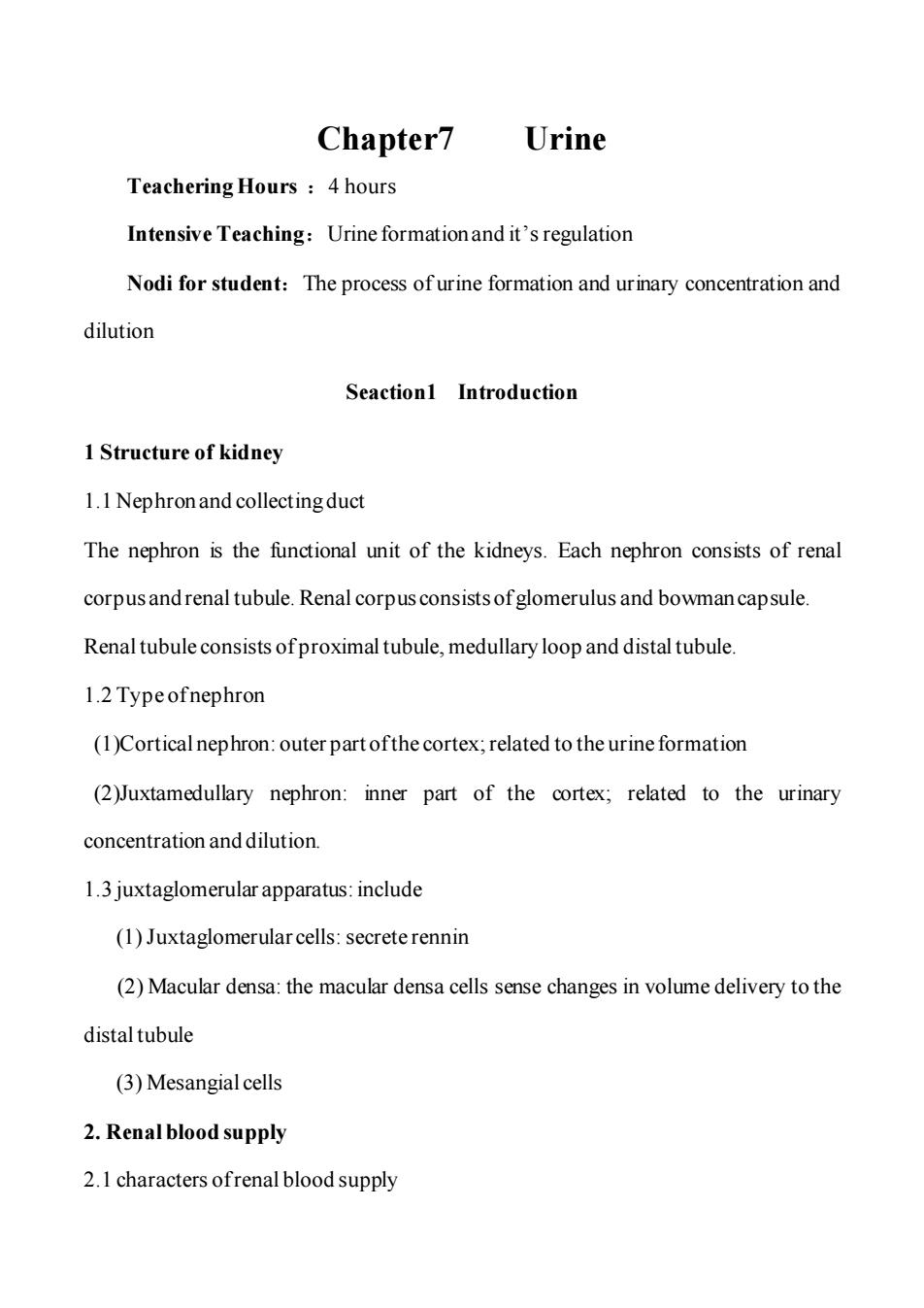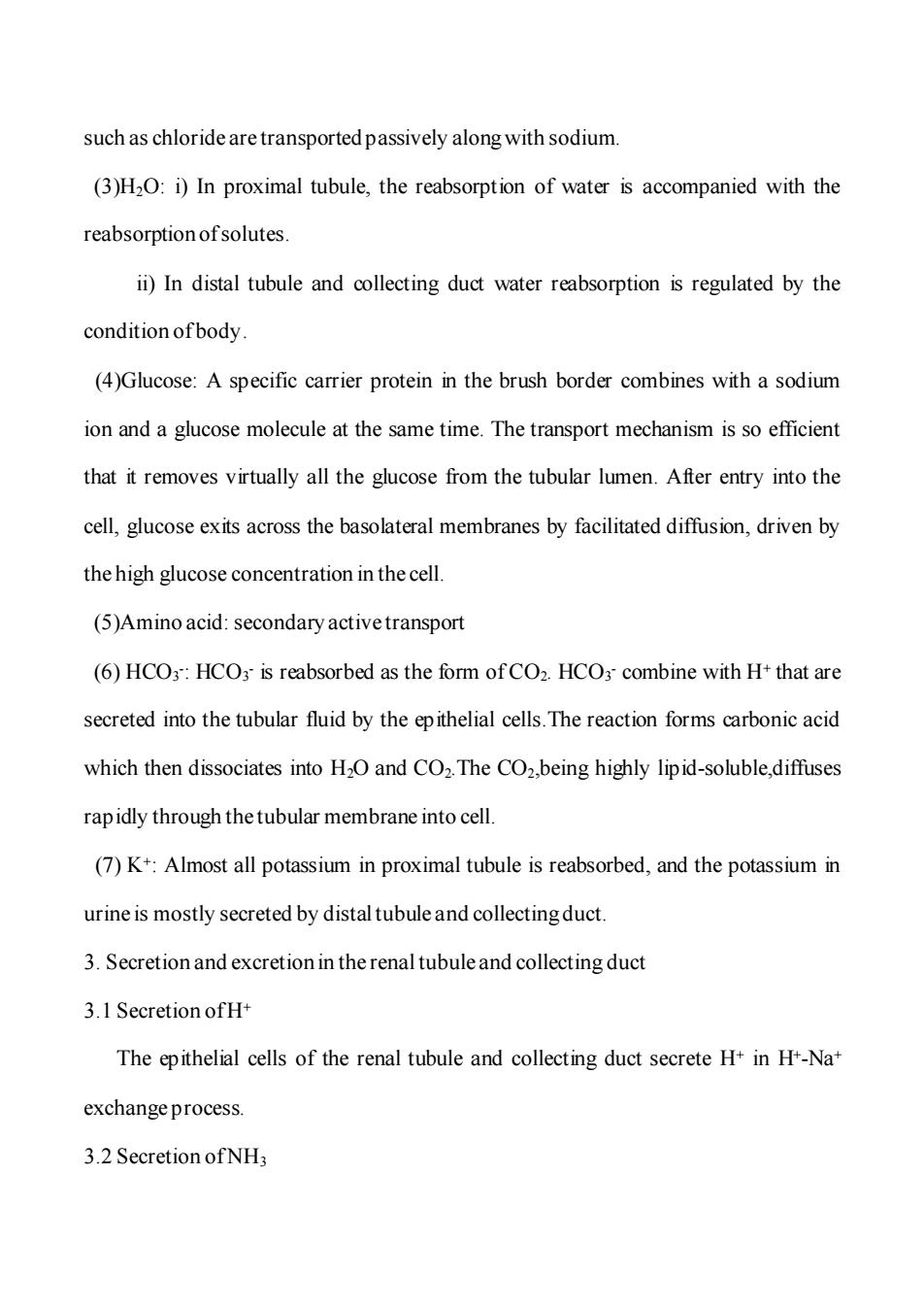
Chapter7 Urine Teachering Hours 4 hours Intensive Teaching:Urine formation and it's regulation Nodi for student:The process ofurine formation and urinary concentration and dilution Seaction1 Introduction 1 Structure of kidney 1.1 Nephron and collecting duct The nephron is the functional unit of the kidneys.Each nephron consists of renal corpus and renal tubule.Renal corpus consists ofglomerulus and bowman capsule. Renal tubule consists ofproximal tubule,medullary loop and distal tubule. 1.2 Typeofnephron (1)Cortical nephron:outer part ofthe cortex;related to the urine formation (2)Juxtamedullary nephron:inner part of the cortex;related to the urinary concentration and dilution. 1.3 juxtaglomerular apparatus:include (1)Juxtaglomerular cells:secrete rennin (2)Macular densa:the macular densa cells sense changes in volume delivery to the distal tubule (3)Mesangial cells 2.Renal blood supply 2.1 characters ofrenal blood supply
Chapter7 Urine Teachering Hours :4 hours Intensive Teaching:Urine formation and it’s regulation Nodi for student:The process of urine formation and urinary concentration and dilution Seaction1 Introduction 1 Structure of kidney 1.1 Nephron and collecting duct The nephron is the functional unit of the kidneys. Each nephron consists of renal corpus and renal tubule. Renal corpus consists of glomerulus and bowman capsule. Renal tubule consists of proximal tubule, medullary loop and distal tubule. 1.2 Type of nephron (1)Cortical nephron: outer part of the cortex; related to the urine formation (2)Juxtamedullary nephron: inner part of the cortex; related to the urinary concentration and dilution. 1.3 juxtaglomerular apparatus: include (1) Juxtaglomerular cells: secrete rennin (2) Macular densa: the macular densa cells sense changes in volume delivery to the distal tubule (3) Mesangial cells 2. Renal blood supply 2.1 characters of renal blood supply

2.2 regulation ofrenal blood flow (1)Autoregulation:perfusion pressure at 80~180mmHg (2)Sympathetic nervous system and hormonal or autacoid control of renal blood flow. Seaction2 Urine Formation The formation of urine includes three basic processes:glomerular filtration; reabsorption in the renal tubule and collecting duct;secretion and excretion in the renal tubule and collecting duct. 1.Glomerular filtration Glomerular filtration rate:The rate at which fluid filters from the blood into Bowman's capsule. (1)the glomerular capillary membrane and its permeability Glomerular filtration barrier:Glomerular capillary endothelium;basal lamina; epithelium (2)Effective filtration pressure(EFP) EFP=glomerular hydrostatic pressure -(glomerular colloid osmotic pressure+Bowman's capsule pressure) 2.Reabsorption in the renal tubule and collecting duct The proximal tubule is the main site of reabsorption where glucose,amino acids and vitamins are completely reabsorbed.CI-,HCO3-,and H2O are partly reabsorbed,while creatinine is not absorbed at all.The reabsorption is selective and independent of hormone control.Na+and K*are reabsorbed actively,glucose and amino
2.2 regulation of renal blood flow (1) Autoregulation: perfusion pressure at 80~180mmHg (2) Sympathetic nervous system and hormonal or autacoid control of renal blood flow. Seaction2 Urine Formation The formation of urine includes three basic processes: glomerular filtration; reabsorption in the renal tubule and collecting duct; secretion and excretion in the renal tubule and collecting duct. 1. Glomerular filtration Glomerular filtration rate: The rate at which fluid filters from the blood into Bowman’s capsule. (1) the glomerular capillary membrane and its permeability Glomerular filtration barrier: Glomerular capillary endothelium; basal lamina; epithelium (2) Effective filtration pressure (EFP) EFP= glomerular hydrostatic pressure - (glomerular colloid osmotic pressure+Bowman’s capsule pressure) 2. Reabsorption in the renal tubule and collecting duct The proximal tubule is the main site of reabsorption where glucose,amino acids and vitamins are completely reabsorbed.Cl- ,HCO3- ,and H2O are partly reabsorbed,while creatinine is not absorbed at all.The reabsorption is selective and independent of hormone control.Na+ and K+are reabsorbed actively,glucose and amino

acids are transported by secondary active mechanism(correlated with Na),where H20,CI-,and HCO3-are transported passively.The distal convoluted tubule and collecting duct reabsorb NaCl,K+,HCO3-,in a hormone-dependent fashion.The secretion of K+,H+,and NH3 by the tubule cells promote reabsorption of plasma HCO3-,which plays a predominant role in homeostatic regulation 2.1Type ofreabsorption (1)Passive transport:Water and solutes are transported across the tubular epithelial cells into the extracellular fluid that is mediated by electronic and chemical forces (2)Active transport:Active transport can move a solute against an electrochemical gradient and requires energy derived from metabolism. 2.2 Reabsorption ofsome substances (1)Na+:i)Proximal tubule:active transport in pump-leak model DThere is a concentration gradient favoring sodium diffusioninto the cell. 2The cell has sodium pump to transport sodium out of the cell into the interstitial. 3Water moves to the interstitial by osmosis,and it leads to a high level of hydrostatic pressure in interstitial. 4 Sodium and water are reabsorbed from the interstitial fluid into the peritubular capillaries by hydrostatic pressure ,meanwhile,there also exits leakage from interstitial fluid to tubule. ii)Henle's loop ascending limb:passive transport. (2)CI:When sodium is reabsorbed through the tubular epithelial cell,negative ions
acids are transported by secondary active mechanism(correlated with Na +),where H2O,Cl-,and HCO3-are transported passively.The distal convoluted tubule and collecting duct reabsorb NaCl,K+,HCO3-,in a hormone-dependent fashion.The secretion of K+,H+,and NH3 by the tubule cells promote reabsorption of plasma HCO3-,which plays a predominant role in homeostatic regulation 2.1Type of reabsorption (1) Passive transport: Water and solutes are transported across the tubular epithelial cells into the extracellular fluid that is mediated by electronic and chemical forces. (2) Active transport: Active transport can move a solute against an electrochemical gradient and requires energy derived from metabolism. 2.2 Reabsorption of some substances (1)Na+: i) Proximal tubule: active transport in pump-leak model ①There is a concentration gradient favoring sodium diffusion into the cell. ②The cell has sodium pump to transport sodium out of the cell into the interstitial. ③Water moves to the interstitial by osmosis, and it leads to a high level of hydrostatic pressure in interstitial. ④ Sodium and water are reabsorbed from the interstitial fluid into the peritubular capillaries by hydrostatic pressure ,meanwhile, there also exits leakage from interstitial fluid to tubule. ii) Henle‘s loop ascending limb: passive transport. (2)Cl- : When sodium is reabsorbed through the tubular epithelial cell, negative ions

such as chloride are transported passively along with sodium. (3)H2O:i)In proximal tubule,the reabsorption of water is accompanied with the reabsorption ofsolutes. ii)In distal tubule and collecting duct water reabsorption is regulated by the condition ofbody. (4)Glucose:A specific carrier protein in the brush border combines with a sodium ion and a glucose molecule at the same time.The transport mechanism is so efficient that it removes virtually all the glucose from the tubular lumen.After entry into the cell,glucose exits across the basolateral membranes by facilitated diffusion,driven by the high glucose concentration in the cell. (5)Amino acid:secondary activetransport (6)HCO3:HCO3 is reabsorbed as the form of CO2.HCO3 combine with H+that are secreted into the tubular fluid by the epithelial cells.The reaction forms carbonic acid which then dissociates into H2O and CO2.The CO2,being highly lipid-soluble,diffuses rapidly through the tubular membrane into cell. (7)K+:Almost all potassium in proximal tubule is reabsorbed,and the potassium in urine is mostly secreted by distal tubule and collecting duct. 3.Secretion and excretion in the renal tubule and collecting duct 3.1 Secretion ofH+ The epithelial cells of the renal tubule and collecting duct secrete H+in H+-Na exchange process. 3.2 Secretion ofNH;
such as chloride are transported passively along with sodium. (3)H2O: i) In proximal tubule, the reabsorption of water is accompanied with the reabsorption of solutes. ii) In distal tubule and collecting duct water reabsorption is regulated by the condition of body. (4)Glucose: A specific carrier protein in the brush border combines with a sodium ion and a glucose molecule at the same time. The transport mechanism is so efficient that it removes virtually all the glucose from the tubular lumen. After entry into the cell, glucose exits across the basolateral membranes by facilitated diffusion, driven by the high glucose concentration in the cell. (5)Amino acid: secondary active transport (6) HCO3 - : HCO3 - is reabsorbed as the form of CO2. HCO3 - combine with H+ that are secreted into the tubular fluid by the epithelial cells.The reaction forms carbonic acid which then dissociates into H2O and CO2.The CO2,being highly lipid-soluble,diffuses rapidly through the tubular membrane into cell. (7) K+: Almost all potassium in proximal tubule is reabsorbed, and the potassium in urine is mostly secreted by distal tubule and collecting duct. 3. Secretion and excretion in the renal tubule and collecting duct 3.1 Secretion of H+ The epithelial cells of the renal tubule and collecting duct secrete H+ in H+-Na+ exchange process. 3.2 Secretion of NH3

The epithelial cells of the distal tubule and collecting duct produce NH3 during the process ofmetabolism. NH,in the cells diffuses into the lumen through the luminal membrane because the membrane is highly permeable to it.NH3 in the tubular fluid combines with secreted H+to form NH4+.NH4+is excreted in the urine.Therefore.NH;secretion is closely related to the H+secretion. 3.3 Secretion ofK+ The distal tubule and collecting tubule secrete K+in K+-Na+exchange process. Seaction3 Urinary Concentration and Dilution Renal mechanisms ofurinary concentration and dilution:countercurrent multiplication and countercurrent exchange 1.Mechanisms for creating osmotic gradient in the medullary interstitial fluid (1)The main force is active transport of sodium ions and co-transport of potassium, chloride,and other ions out of the thick portion of the ascending limb of the loop of Henle into the medullary interstitial. (2)Passive diffusion of large amounts of urea from the inner medullary collecting ducts into the medullary interstitial and NaCl from thin segment ofascending limb (3)The main force is the active transport of sodium ions and chloride ions in thick portion of the ascending limb of the loop of Henle,and urea recirculation also contributes to the whole hyperosmotic renal medullary interstitial (4)In distal tubule and collecting duct,there is little permeability to urea,and water is reabsorbed,so that the concentration ofurea rises gradually
The epithelial cells of the distal tubule and collecting duct produce NH3 during the process of metabolism. NH3 in the cells diffuses into the lumen through the luminal membrane because the membrane is highly permeable to it.NH3 in the tubular fluid combines with secreted H+ to form NH4 +.NH4 + is excreted in the urine. Therefore, NH3 secretion is closely related to the H+ secretion. 3.3 Secretion of K+ The distal tubule and collecting tubule secrete K+ in K+-Na+ exchange process. Seaction3 Urinary Concentration and Dilution Renal mechanisms of urinary concentration and dilution: countercurrent multiplication and countercurrent exchange 1. Mechanismsfor creating osmotic gradient in the medullary interstitial fluid (1) The main force is active transport of sodium ions and co-transport of potassium, chloride, and other ions out of the thick portion of the ascending limb of the loop of Henle into the medullary interstitial. (2) Passive diffusion of large amounts of urea from the inner medullary collecting ducts into the medullary interstitial and NaCl from thin segment of ascending limb. (3) The main force is the active transport of sodium ions and chloride ions in thick portion of the ascending limb of the loop of Henle, and urea recirculation also contributes to the whole hyperosmotic renal medullary interstitial (4) In distal tubule and collecting duct, there is little permeability to urea, and water is reabsorbed, so that the concentration of urea rises gradually